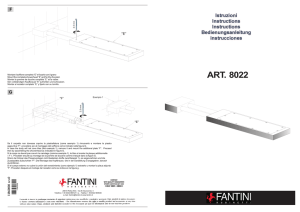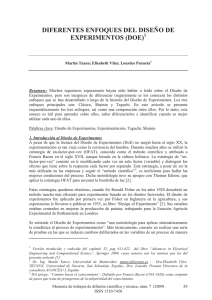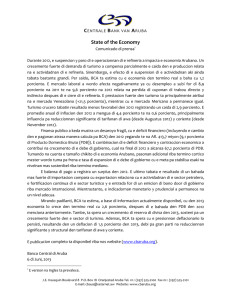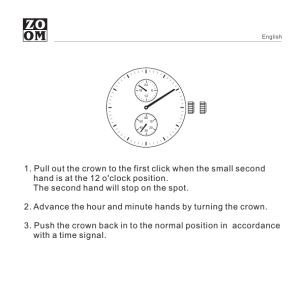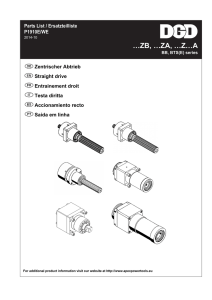Friktionszylinder neu.indd
Anuncio
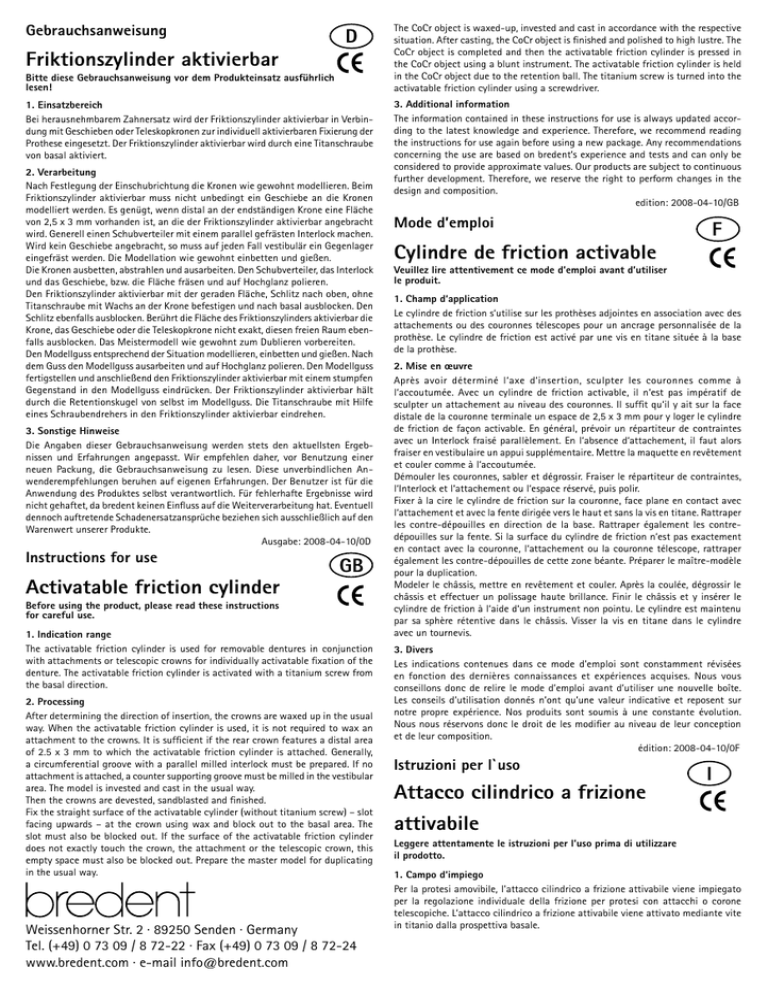
Gebrauchsanweisung Friktionszylinder aktivierbar D Bitte diese Gebrauchsanweisung vor dem Produkteinsatz ausführlich lesen! 1. Einsatzbereich Bei herausnehmbarem Zahnersatz wird der Friktionszylinder aktivierbar in Verbindung mit Geschieben oder Teleskopkronen zur individuell aktivierbaren Fixierung der Prothese eingesetzt. Der Friktionszylinder aktivierbar wird durch eine Titanschraube von basal aktiviert. 2. Verarbeitung Nach Festlegung der Einschubrichtung die Kronen wie gewohnt modellieren. Beim Friktionszylinder aktivierbar muss nicht unbedingt ein Geschiebe an die Kronen modelliert werden. Es genügt, wenn distal an der endständigen Krone eine Fläche von 2,5 x 3 mm vorhanden ist, an die der Friktionszylinder aktivierbar angebracht wird. Generell einen Schubverteiler mit einem parallel gefrästen Interlock machen. Wird kein Geschiebe angebracht, so muss auf jeden Fall vestibulär ein Gegenlager eingefräst werden. Die Modellation wie gewohnt einbetten und gießen. Die Kronen ausbetten, abstrahlen und ausarbeiten. Den Schubverteiler, das Interlock und das Geschiebe, bzw. die Fläche fräsen und auf Hochglanz polieren. Den Friktionszylinder aktivierbar mit der geraden Fläche, Schlitz nach oben, ohne Titanschraube mit Wachs an der Krone befestigen und nach basal ausblocken. Den Schlitz ebenfalls ausblocken. Berührt die Fläche des Friktionszylinders aktivierbar die Krone, das Geschiebe oder die Teleskopkrone nicht exakt, diesen freien Raum ebenfalls ausblocken. Das Meistermodell wie gewohnt zum Dublieren vorbereiten. Den Modellguss entsprechend der Situation modellieren, einbetten und gießen. Nach dem Guss den Modellguss ausarbeiten und auf Hochglanz polieren. Den Modellguss fertigstellen und anschließend den Friktionszylinder aktivierbar mit einem stumpfen Gegenstand in den Modellguss eindrücken. Der Friktionszylinder aktivierbar hält durch die Retentionskugel von selbst im Modellguss. Die Titanschraube mit Hilfe eines Schraubendrehers in den Friktionszylinder aktivierbar eindrehen. 3. Sonstige Hinweise Die Angaben dieser Gebrauchsanweisung werden stets den aktuellsten Ergebnissen und Erfahrungen angepasst. Wir empfehlen daher, vor Benutzung einer neuen Packung, die Gebrauchsanweisung zu lesen. Diese unverbindlichen Anwenderempfehlungen beruhen auf eigenen Erfahrungen. Der Benutzer ist für die Anwendung des Produktes selbst verantwortlich. Für fehlerhafte Ergebnisse wird nicht gehaftet, da bredent keinen Einfluss auf die Weiterverarbeitung hat. Eventuell dennoch auftretende Schadenersatzansprüche beziehen sich ausschließlich auf den Warenwert unserer Produkte. Ausgabe: 2008-04-10/0D Instructions for use Activatable friction cylinder GB Before using the product, please read these instructions for careful use. 1. Indication range The activatable friction cylinder is used for removable dentures in conjunction with attachments or telescopic crowns for individually activatable fixation of the denture. The activatable friction cylinder is activated with a titanium screw from the basal direction. 2. Processing After determining the direction of insertion, the crowns are waxed up in the usual way. When the activatable friction cylinder is used, it is not required to wax an attachment to the crowns. It is sufficient if the rear crown features a distal area of 2.5 x 3 mm to which the activatable friction cylinder is attached. Generally, a circumferential groove with a parallel milled interlock must be prepared. If no attachment is attached, a counter supporting groove must be milled in the vestibular area. The model is invested and cast in the usual way. Then the crowns are devested, sandblasted and finished. Fix the straight surface of the activatable cylinder (without titanium screw) – slot facing upwards – at the crown using wax and block out to the basal area. The slot must also be blocked out. If the surface of the activatable friction cylinder does not exactly touch the crown, the attachment or the telescopic crown, this empty space must also be blocked out. Prepare the master model for duplicating in the usual way. Weissenhorner Str. 2 · 89250 Senden · Germany Tel. (+49) 0 73 09 / 8 72-22 · Fax (+49) 0 73 09 / 8 72-24 www.bredent.com · e-mail [email protected] The CoCr object is waxed-up, invested and cast in accordance with the respective situation. After casting, the CoCr object is finished and polished to high lustre. The CoCr object is completed and then the activatable friction cylinder is pressed in the CoCr object using a blunt instrument. The activatable friction cylinder is held in the CoCr object due to the retention ball. The titanium screw is turned into the activatable friction cylinder using a screwdriver. 3. Additional information The information contained in these instructions for use is always updated according to the latest knowledge and experience. Therefore, we recommend reading the instructions for use again before using a new package. Any recommendations concerning the use are based on bredent‘s experience and tests and can only be considered to provide approximate values. Our products are subject to continuous further development. Therefore, we reserve the right to perform changes in the design and composition. edition: 2008-04-10/GB Mode d’emploi Cylindre de friction activable F Veuillez lire attentivement ce mode d’emploi avant d’utiliser le produit. 1. Champ d‘application Le cylindre de friction s‘utilise sur les prothèses adjointes en association avec des attachements ou des couronnes télescopes pour un ancrage personnalisée de la prothèse. Le cylindre de friction est activé par une vis en titane située à la base de la prothèse. 2. Mise en œuvre Après avoir déterminé l‘axe d‘insertion, sculpter les couronnes comme à l‘accoutumée. Avec un cylindre de friction activable, il n‘est pas impératif de sculpter un attachement au niveau des couronnes. Il suffit qu‘il y ait sur la face distale de la couronne terminale un espace de 2,5 x 3 mm pour y loger le cylindre de friction de façon activable. En général, prévoir un répartiteur de contraintes avec un Interlock fraisé parallèlement. En l‘absence d‘attachement, il faut alors fraiser en vestibulaire un appui supplémentaire. Mettre la maquette en revêtement et couler comme à l‘accoutumée. Démouler les couronnes, sabler et dégrossir. Fraiser le répartiteur de contraintes, l‘Interlock et l‘attachement ou l‘espace réservé, puis polir. Fixer à la cire le cylindre de friction sur la couronne, face plane en contact avec l‘attachement et avec la fente dirigée vers le haut et sans la vis en titane. Rattraper les contre-dépouilles en direction de la base. Rattraper également les contredépouilles sur la fente. Si la surface du cylindre de friction n‘est pas exactement en contact avec la couronne, l‘attachement ou la couronne télescope, rattraper également les contre-dépouilles de cette zone béante. Préparer le maître-modèle pour la duplication. Modeler le châssis, mettre en revêtement et couler. Après la coulée, dégrossir le châssis et effectuer un polissage haute brillance. Finir le châssis et y insérer le cylindre de friction à l‘aide d‘un instrument non pointu. Le cylindre est maintenu par sa sphère rétentive dans le châssis. Visser la vis en titane dans le cylindre avec un tournevis. 3. Divers Les indications contenues dans ce mode d’emploi sont constamment révisées en fonction des dernières connaissances et expériences acquises. Nous vous conseillons donc de relire le mode d’emploi avant d’utiliser une nouvelle boîte. Les conseils d’utilisation donnés n’ont qu’une valeur indicative et reposent sur notre propre expérience. Nos produits sont soumis à une constante évolution. Nous nous réservons donc le droit de les modifier au niveau de leur conception et de leur composition. édition: 2008-04-10/0F Istruzioni per l`uso Attacco cilindrico a frizione I attivabile Leggere attentamente le istruzioni per l’uso prima di utilizzare il prodotto. 1. Campo d‘impiego Per la protesi amovibile, l’attacco cilindrico a frizione attivabile viene impiegato per la regolazione individuale della frizione per protesi con attacchi o corone telescopiche. L’attacco cilindrico a frizione attivabile viene attivato mediante vite in titanio dalla prospettiva basale. 2. Lavorazione Dopo avere stabilito l’asse d’inserzione, modellare le corone come di consueto. Se si utilizza un attacco cilindrico a frizione attivabile non bisogna necessariamente modellare un attacco a contatto con le corone: è sufficiente che la superficie distale della corona telescopica o del fresaggio sia di almeno 2,5 x 3 mm. Predisporre in generale un fresaggio a pareti parallele con interlock o coulisses contrapposte. Se non si applica alcun attacco, occorre comunque integrare un controalloggiamento a livello vestibolare. Procedere alla messa in rivestimento e alla fusione come di consueto. Smuffolare le corone, sabbiarle e rifinirle. Fresare e lucidare a specchio il fresaggio, l’interlock e l’attacco / superficie distale. Posizionare l’attacco cilindrico a frizione attivabile con la parete piana, fessura verso l’alto, senza vite in titanio, a contatto con la corona. Scaricare basalmente l’attacco, scaricare anche la fessura. Se la superficie dell’attacco cilindrico a frizione attivabile non interferisce esattamente con la corona, con l’attacco o con la corona telescopica, scaricare anche questo spazio libero. Preparare il modello Master per la duplicazione, come di consueto. Modellare lo scheletrato, metterlo in rivestimento e procedere alla fusione. Dopo la fusione, rifinire lo scheletrato e lucidarlo a specchio. Ultimare la protesi e, in seguito, inserire l’attacco cilindrico a frizione attivabile nello scheletrato con uno strumento non appuntito. Grazie alla tacca ritentiva è garantita una tenuta sicura dell’attacco cilindrico a frizione nello scheletrato. Calibrare la tenuta della protesi regolando la vite in titanio con l’aiuto di un cacciavite. 3. Consejos adicionales La información sobre el producto se acoge a los últimos resultados y experiencias sobre el mismo. Por ello aconsejamos antes de su uso leer de nuevo la información sobre el producto. Todos los consejos con respecto a su manipulación se basan en nuestra propia experiencia y solo se podrá ver como información orientativa. Nuestros productos están constantemente a desarrollo. Nos reservamos el derecho de cualquier cambio en su construcción y composición. édition: 2008-04-10/0E 3. Altre indicazioni Queste istruzioni d‘uso sono costantemente aggiornate in base alle più recenti esperienze e conoscenze. Consigliamo perciò, prima dell‘uso di una nuova confezione, di leggere nuovamente le istruzioni d’uso. Tutti i consigli relativi all’utilizzo, si basano sulle nostre prove ed esperienze e possono perciò essere considerati solo valori indicativi. I nostri prodotti sono continuamente sottoposti ad ulteriori sviluppi. Ci riserviamo perciò modifiche nella composizione e nella fabbricazione. edizione: 2008-04-10/OI Folleto de instrucciones Cilindro de fricción activable E Rogamos lean antes de usar el producto la hoja de información. 1. Campo de uso Se puede utilizar el atache cilíndrico activable en caso de prótesis removible conjuntamente con coronas telescópicas ó ataches para conseguir individualmente la fricción deseada. El atache cilíndrico se activará por medio de un tornillo de titanio por la parte de abajo. Weissenhorner Str. 2 · 89250 Senden · Germany Tel. (+49) 0 73 09 / 8 72-22 · Fax (+49) 0 73 09 / 8 72-24 www.bredent.com · e-mail [email protected] 000239EX 2. Modo de trabajo Después de haber establecido la dirección de entrada, modelar las coronas como de costumbre. No hace falta modelar un atache a la corona si se utiliza el atache cilíndrico activable. Solo hace falta crear en distal de la corona modelada una superficie d e 2,5 x 3 mm donde se pueda fijar el atache cilíndrico activable. Realizar por norma una contorno fresado con Interlock fresado paralelo. Si no se colocase un atache en la corona se deberá posicionar una contra estabilizador por la parte vestibular. Revestir y colar como de costumbre el modelado. Retirar el revestimiento, repasar y pulir la estructura. Refresar el contorno fresado, Interlock y el atache y darle brillo. Posicionar el atache cilíndrico con la superficie ranurada hacia arriba; fijar con cera y sin al tronillo de titanio el atache cilíndrico activable a la corona y aliviar la zona de abajo. Aliviar también la ranura del atache cilíndrico activable. Si tocase el atache cilíndrico activable la pared la corona, el atache o las coranas telescópicas no son exactas, aliviar también este espacio con cera. Preparar el modelo maestro como de costumbre para duplicar. Modelar el esquelético según la situación del trabajo, revestir y colar. Después de colar, repasar y pulir la estructura. Terminar el montaje del esquelético y terminarlo. A continuación introducir con ayuda de un instrumento el atache cilíndrico activable en el esquelético. El atache cilíndrico activable se mantiene en el esquelético gracias a la bola de retención. Enroscar con ayuda de un destornillador el tornillo de titanio.
